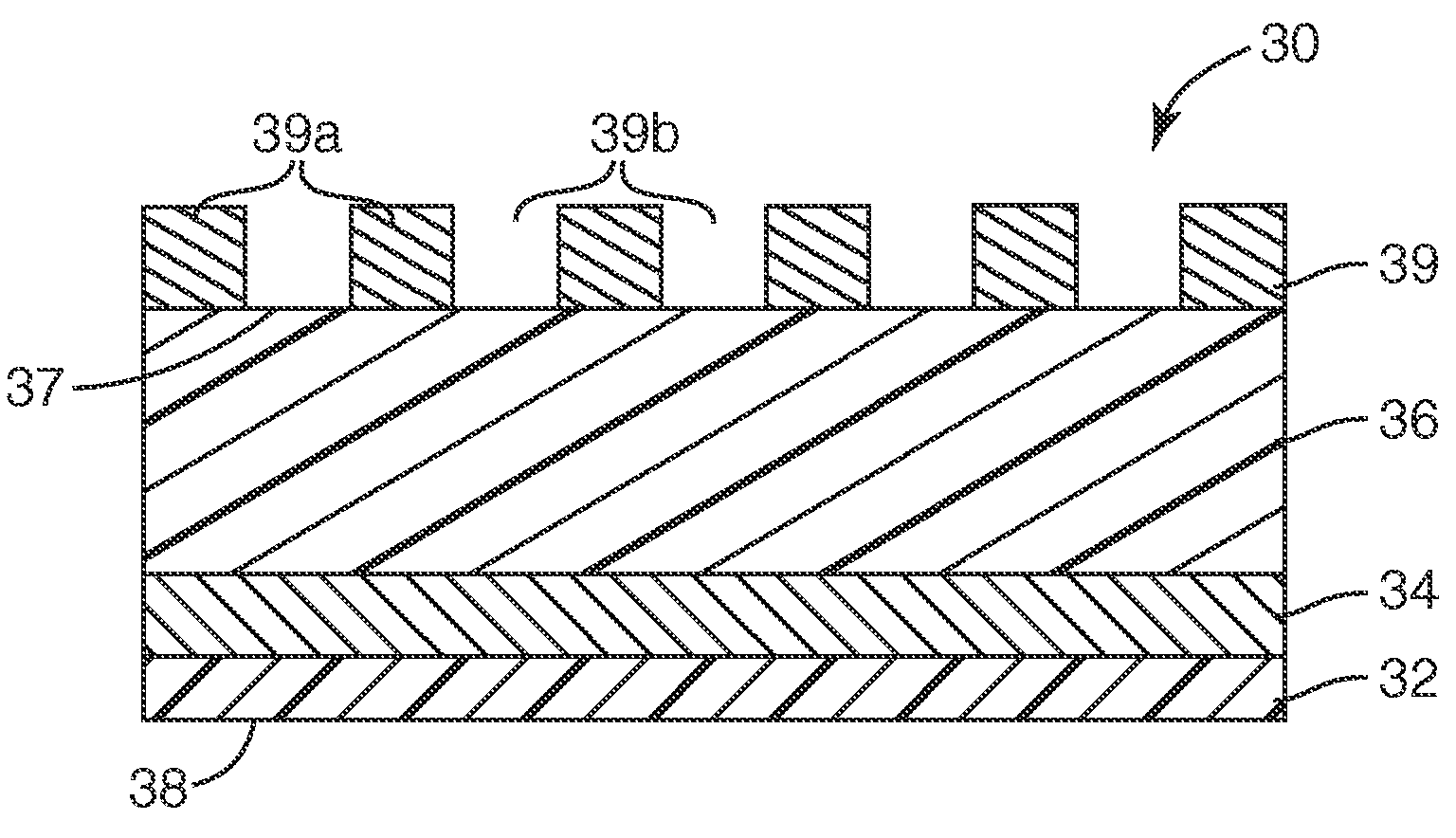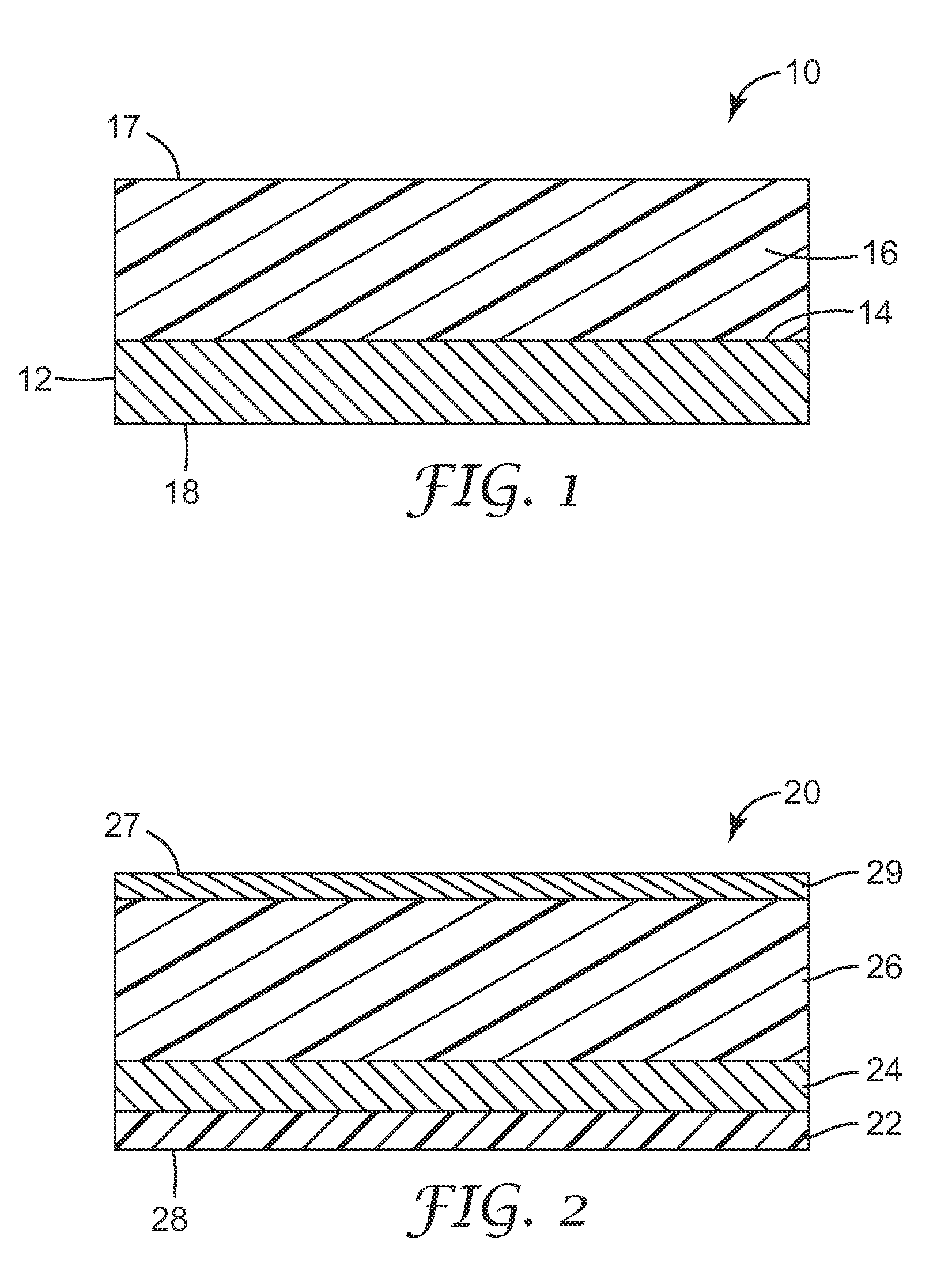Colorimetric sensors
a colorimetric sensor and sensor technology, applied in the field of colorimetric sensors, can solve the problems of limited tunability, potential photobleaching of photochromic dyes, and difficulty in detecting radiation within certain desired ranges, and achieve the effect of fast and permanent responses
- Summary
- Abstract
- Description
- Claims
- Application Information
AI Technical Summary
Benefits of technology
Problems solved by technology
Method used
Image
Examples
examples
[0120]The present invention may be illustrated by way of the following examples. Unless otherwise stated, the multi-layered colorimetric sensor samples were viewed from an angle normal to the surface of the sensor. Other viewing angles may be used. The color observed can vary depending on the angle of observation.
[0121]The following examples are merely for illustrative purposes and are not meant to be limiting on the scope of the appended claims. All parts, percentages, ratios, etc. in the examples and the rest of the specification are by weight, unless noted otherwise. Solvents and other reagents used were obtained from Sigma-Aldrich Chemical Company (Milwaukee, Wis.) unless otherwise noted.
[0122]The following materials were used in the examples:
[0123]
Abbreviation orTradeDesignationDescriptionVAZO-672,2-azobis(2-methylbutyronitrile) commerciallyavailable from E. I. duPont de Nemours& Co. (Wilmington, DE)TMPTAtrimethylolpropane triacrylate, commerciallyavailable from Sartomer (Exton...
example p1
Preparative Example P1
[0125]A homopolymer of cyclohexyl acrylate (PCHA) was prepared. In ajar, 49.33 grams of cyclohexyl acrylate, 0.55 gram of isooctyl 3-mercaptopropionate, and 0.21 gram of VAZO-67 were dissolved in 125 milliliters of toluene. The jar was sealed, placed in a water shaker bath and heated at 80° C. for 16 hours. The reaction mixture was evaporated to half of its original volume under reduced pressure. The resulting solution was poured into methanol and a precipitate formed. The solvent was decanted off and the precipitate was redissolved in toluene. This precipitation procedure was performed a total of three times. After the third precipitation, the solid was dried under high vacuum in a vacuum oven at 60° C. for 20 hours to yield a clear solid (38.37 grams). GPC analysis of the purified polymer showed it to have Mw=34,200, Mn=13,300, and a polydispersity of 2.58.
Preparative Examples P2-P3
[0126]Curable compositions were prepared by mixing a solution of the PCHA from...
example p8
Preparative Example P8
[0130]In a glass polymerization bottle was placed 1.5 grams IBA, 6.5 grams IOA, 2.0 grams VDM, 10 grams ethyl acetate, 0.15 gram carbon tetrabromide, and 0.05 gram benzoyl peroxide. The bottle was purged with nitrogen, sealed and shaken in a water bath maintained at 60° C. for 17 hours. The ethyl acetate was removed under reduced pressure to produce a copolymer with Mw=42,200, Mn=16,500, and a polydispersity of 2.56 as measured by GPC.
PUM
| Property | Measurement | Unit |
|---|---|---|
| specular reflectance | aaaaa | aaaaa |
| specular reflectance | aaaaa | aaaaa |
| boiling point | aaaaa | aaaaa |
Abstract
Description
Claims
Application Information
 Login to View More
Login to View More - R&D
- Intellectual Property
- Life Sciences
- Materials
- Tech Scout
- Unparalleled Data Quality
- Higher Quality Content
- 60% Fewer Hallucinations
Browse by: Latest US Patents, China's latest patents, Technical Efficacy Thesaurus, Application Domain, Technology Topic, Popular Technical Reports.
© 2025 PatSnap. All rights reserved.Legal|Privacy policy|Modern Slavery Act Transparency Statement|Sitemap|About US| Contact US: help@patsnap.com



